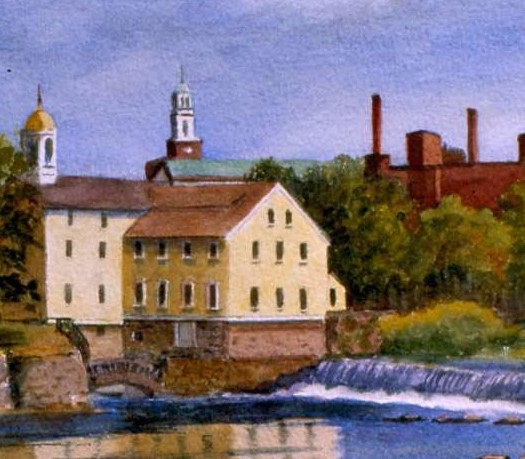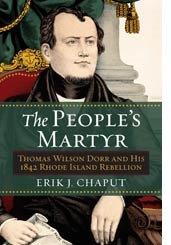The People’s Martyr, by Erik J. Chaput (Lawrence, Kansas: University Press of Kansas, 2013)
“The Rhode Island Question,” otherwise known as the Dorr Rebellion of 1842, is one of the great chapters and turning points in Rhode Island history. Many fine works of history have combed through the newspaper and pamphlet literature of the day. Archival collections of the letters of the principals have received dutiful scrutiny. With all due respect to these scholars, however, not until Erik Chaput’s The People’s Martyr has the full story—all of the sub-themes, been so richly told. No doubt Chaput benefited from nearly a scholarly life time of devotion by master practitioners such as RI Historian Laureate, Dr. Patrick Conley, but his work is fuller and more far reaching than any who have gone before. Some writing about Dorr has been superficial. Some has been sarcastic, casting Dorr as a dim-witted comic opera character, his antics almost cartoonish. To these, by contrast, Chaput’s work is a majestic, full-fledged opera, with great scenery, powerful music, and tragic moments.
From the time of the event, itself, Dorr’s Rebellion, the Dorr War, or ‘the Rhode Island Question’, generated a combative literature which attempted to explain the events and the personalities of the constitutional crisis in which a majority of the males of voting age were denied access to the polls because they failed sufficient property ownership, required by law, to qualify them as electors. For many years following the initial literature which argued both sides of the ‘Question’, Dorr was regarded in print as misguided at best or a radical at worst. His popularity among a core of reformers and out-of-office Democrats smoldered for ninety years, and flared up in the victory statement of Governor Theodore Francis Green the night his Bloodless Revolution of 1935 gained control of both houses of the Rhode Island legislature as well as the Governorship. “The spirit of Thomas Wilson Dorr has finally triumphed in Rhode Island,” he announced in a late evening state-wide radio broadcast.
As recently as 1945, in his Age of Jackson, liberal historian, Arthur M. Schlesinger, Jr. characterized Arthur May Mowry’s The Dorr War, as the best history on the subject. Today, most historians see Mowry’s account as a biased and an arch conservative’s description of the events of 1842. Beginning in the1960s, a new generation of historians cast Dorr and his cause in a more sympathetic light. This younger company of scholars—Botelho, Coleman, Conley, Dennison, DeSimone, Ernst Formisano, Gersurny, Gettleman, Gilkeson, Hayman, Lemons, Molloy, Rae, Raven, Widmer, and Wiecek—have broadened the study of Dorr and his times, dug more deeply into the issues of popular constituent sovereignty, and the role played by the advent of Catholic bigotry, and the rising issues of labor grievances and women’s suffrage. One might wonder what was left for Erik Chaput to add.
The answer is a great deal. The Dorr Rebellion is a story of many parts. Frequently, historians have focused on vignettes, tableaus of dramatic events. Some, in their efforts, like Mowry, to discredit Dorr, have lapsed into skit-like comic farce incidents, like misfiring cannons or craven denials and desertions.
Chaput, by contrast, has created a rich background and expanded the stage. It is not as if the more recent analysts of the Rhode Island Question had not drawn background sketches of the Age of Jacksonian Democracy in 1842; they have. The relationship of Dorr’s efforts to the national political scene has been noted. There are books tying in the connections to education reform, to labor issues, to anti-slavery. There are books which explain the origins of the notion of popular constituent sovereignty, the English political theorists. Others have limned the story of the maritime trade and the shift to textiles, as well as the key features in the transportation revolution. Movements like the international peace initiatives and the intimations of future steps to secure women’s voting rights have appeared before. The biographies of all the principals have evolved from small sketches to full-blown scholarly studies.
What has been accomplished by Chaput, however, is that all of this scholarship appears in his work about Dorr. Moreover, he has deepened all of these topics with new research of his own, and the resulting exposition is a joy to read.
















